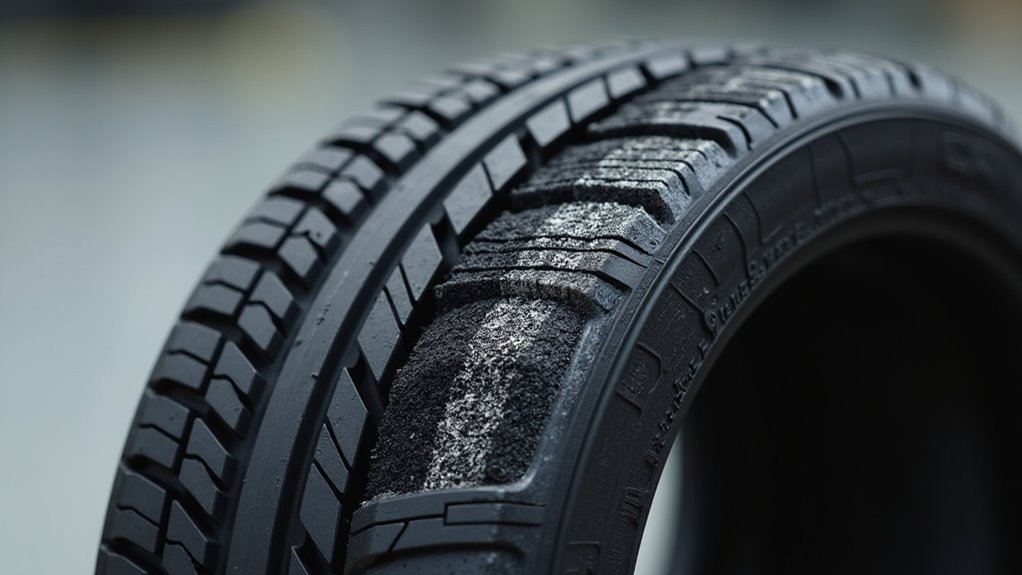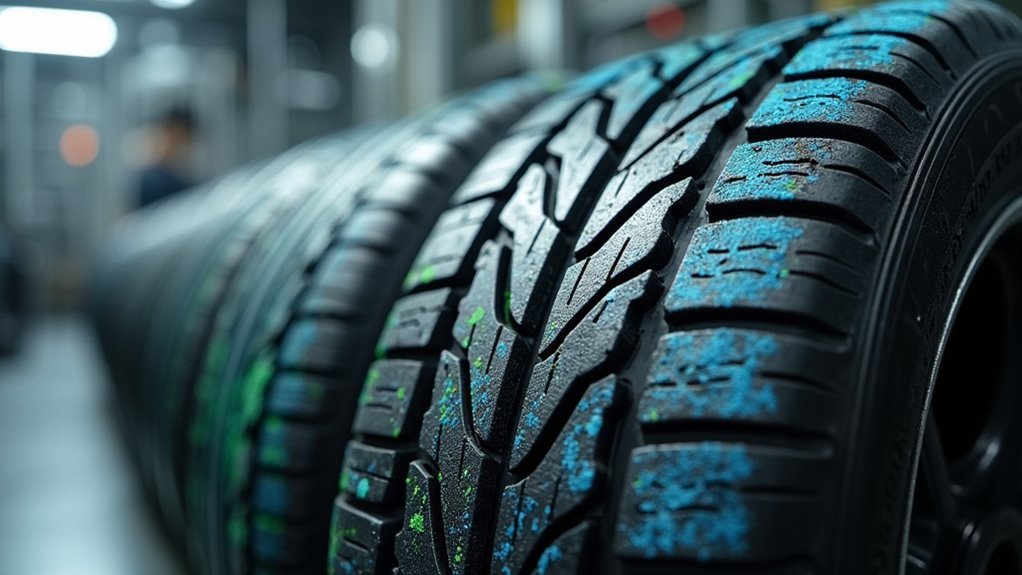What Are Car Tires Made Of
This post contains affiliate links. As an Amazon Associate, we earn from qualifying purchases.
Car tires are made of a complex blend of materials, including natural and synthetic rubber for flexibility, steel cords for strength, and synthetic fibers like nylon for durability. Additional components like carbon black, silica, and chemical additives enhance grip and protect against damage, ensuring safety and performance. For those curious about the intricacies of tire technology, further details and insights will be explored later in the article.
Essential Facts in 30 Seconds
- Car tires are made of natural and synthetic rubber for flexibility and stability.
- Steel cords and synthetic fibers like nylon provide strength and durability.
- Carbon black and silica fillers improve tire grip and durability.
- Chemical additives, such as antioxidants, enhance performance and protection.
- Components like tread, casing, and sidewall ensure safety and efficiency.
Core Components of Tire Composition
Tires are super important for your car’s safety and performance. Let’s break down their main parts.
First, the tire tread. It’s the outer layer that grabs the road. Made from mixed materials, it fights wear and tear. Steel cords inside stop punctures too.
Next, the casing. Think of it as the tire’s inner skeleton. It uses rubber and textile layers to carry weight. This part soaks up bumps and keeps the shape solid.
Then, the bead. It’s got steel wires to lock the tire on the wheel. This gives a strong grip for safe turns. Additionally, the bead core is made of high-strength steel embedded in rubber for extra durability.
Last, the sidewall. It mixes natural and synthetic stuff with fabrics. This adds bend and strength during sharp moves.
Here’s a quick list of these parts:
- Tire Tread: Holds the road, lasts long.
- Casing: Supports heavy loads.
- Bead: Keeps tire on wheel.
- Sidewall: Balances flex and stability.
Pretty cool, right? These parts team up to keep you rolling safely!
Role of Rubber in Tire Performance

Let’s explore how rubber shapes a tire’s performance on the road.
Rubber’s flexibility matters a lot for grip. It uses hysteresis effects to create heat under stress. Think of it like blu tack softening when squeezed. This boosts traction on all kinds of surfaces. So, tires stay firm during sharp turns or quick moves.
Rubber also changes with temperature, affecting safety and efficiency. Cold weather often improves traction on icy roads. The compound behaves differently in the cold. Additionally, bound rubber content in tires influences key performance aspects like rolling resistance. Proper tire size also ensures optimal vehicle handling and compatibility with safety systems.
Check out these key points about rubber:
- Natural Rubber: It increases tear resistance. Tires last longer under tough stress.
- Synthetic Rubber: It gives stability for high speeds or wet roads. It makes up 60% of tire rubber.
Importance of Filler Materials

Filler materials are super important for making tires strong and long-lasting. They help improve durability, save money, and boost tire performance. Think of materials like silica, carbon black, and chalk. These fillers make tires resist wear and tough conditions. They mix well with rubber to cut rolling resistance. This means tires last longer and work great everywhere. Additionally, fillers like carbon black and silica play a key role in enhancing tire strength, ensuring safety and reliability on the road.
Check this simple table for clear details:
| Filler Type | Main Advantage |
|---|---|
| Carbon Black | Makes tires resist punctures |
| Silica | Saves fuel while driving |
| Chalk | Cuts down production costs |
| Mixed Fillers | Balances strength and stretch |
See how fillers matter? They truly shape tire quality. Trust me, good fillers mean better rides!
Strength From Reinforcing Elements

Car tires stay strong thanks to special reinforcing parts. These parts keep tires safe and tough. They help tires perform well on all kinds of roads. Let’s explore what makes tires so durable!
Steel cords are a big part of tire strength. They form the main body and belts. Steel gives tires the power to carry heavy loads. It also keeps tires stiff and steady. Bead cores, made of steel, lock the tire to the wheel. This stops the tire from bending under pressure.
Synthetic fibers like nylon and polyester add extra toughness. Aramid fibers bring even more strength. These materials make the tire last longer. They also improve comfort while driving. Near the bead, they help with sharp steering control.
Radial tires use layered cords for better design. This setup cuts down rolling resistance. Less resistance means better gas mileage for your car. Strong tires save you money over time!
Check out these key reinforcing parts in tires:
- Steel cords: Add stiffness and soak up bumps.
- Nylon or aramid: Improve stability and long-lasting power.
These elements team up to handle daily road challenges. Your tires stay reliable no matter what! Additionally, the tire ply rating determines the load capacity and durability for various vehicle types.
Impact of Chemical Additives

Tires need more than steel cords and fibers to stay strong. Chemical additives make a big difference in performance and life. These additives form 5% to 15% of a tire.
Think of antioxidants and antiozonants like 6PPD. They stop damage from ozone and air. Even at just 0.5% to 2%, they build protective layers. This stops cracks and keeps tires lasting longer.
Plasticizers and accelerators also help a lot. They make tires flexible and tough. Fillers like carbon black improve grip on roads.
But there’s a downside to know. Some chemicals, like 6PPD, leak into soil and water. This can harm nature and create risks.
Check this simple list:
- Antiozonants: Stop tire cracking.
- Plasticizers: Add more bend.
- Fillers: Give better road grip.
Know these additives for smart tire picks. They boost performance but challenge the environment. Make choices with care!
Frequently Asked Questions
How Are Car Tires Manufactured?
Car tires go through an amazing process to become strong and reliable. First, workers mix special rubber compounds for toughness. Next, they shape these into long, thin sheets. Then, they cut and join parts like beads and belts. After that, heat and pressure vulcanize the tire for durability. Did you know? Over 2 billion tires get made every year! This process ensures tires grip roads safely. Pretty neat, huh?
What Is the Tire Recycling Process?
Tire recycling turns old tires into useful things like playground surfaces. First, we collect worn-out tires from different places. Next, machines shred them into small pieces. Then, we separate rubber, steel, and fabric parts. This process cuts down waste in landfills. Stats show millions of tires get recycled yearly. It helps save space and resources. Recycled tires make safe, soft grounds for kids. Communities gain from these sustainable products. Pretty amazing, right?
How Do Tires Affect Fuel Efficiency?
Tires play a big role in fuel efficiency. Keep them at the right pressure. Low pressure creates more drag on the road. This makes your car use more gas. Studies show proper pressure saves up to 3% fuel. Pick tires with a good tread design too. Smart designs cut down rolling resistance. Less resistance means better gas mileage. Make these small changes now. Save money on fuel every day!
Why Do Tires Wear Out Over Time?
Tires wear out over time for clear reasons. Friction from roads rubs them down daily. Their material breaks down with use. Tread patterns fade due to pressure. Bad alignment speeds up the damage. Rough driving habits make it worse. Data shows most tires last 3-5 years. Stay alert to these factors. Keep your ride safe!
How Are Tire Sizes Determined?
Tire sizes might seem tricky, but I’ve got you covered! Look at the numbers on your tire. They show width, sidewall height, and rim diameter. Width is the tire’s size across, in millimeters. Sidewall height is the side part, shown as a percentage. Rim diameter is the wheel size, in inches. Check your car manual for the right specs. This helps you pick the perfect tire. Easy, right? Stick to these details for a safe ride!
Conclusion
Car tires are amazing pieces of engineering. They mix many materials for top performance. Let’s break down what goes into them. Rubber makes up 40-50% of a tire. It includes both natural and synthetic types. Fillers like carbon black and silica are 25-30%. These help make tires strong and last longer. Reinforcements, such as steel and nylon, are 15-20%. They give tires extra toughness. Isn’t that cool?
Every part plays a big role in safety. Strong tires keep you safe on roads. Durability matters for long drives too. Check out more about tire tech. It helps you pick the best ones!
